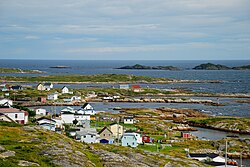Greenspond
|
Greenspond Grin d'Espagne |
|
|---|---|
| Town | |
 |
|
| Nickname(s): Capital of the North | |
| Location of Greenspond in Newfoundland | |
| Coordinates: 49°04′00″N 53°34′34″W / 49.06667°N 53.57611°WCoordinates: 49°04′00″N 53°34′34″W / 49.06667°N 53.57611°W | |
| Country |
|
| Province |
|
| Settled | 1690s |
| Incorporated | 1951 |
| Area | |
| • Total | 2.85 km2 (1.10 sq mi) |
| Population (2011) | |
| • Total | 305 |
| Time zone | Newfoundland Time (UTC-3:30) |
| • Summer (DST) | Newfoundland Daylight (UTC-2:30) |
| Area code(s) | 709 |
 |
|
|
Newfoundland
|
|
| Location | Puffin Island Greenspond Newfoundland Canada |
|---|---|
| Coordinates | 49°3′41.95″N 53°33′3.77″W / 49.0616528°N 53.5510472°W |
| Year first constructed | 1873 (first) |
| Year first lit | 1951 (current) |
| Foundation | concrete base |
| Construction | wooden tower |
| Tower shape | square frustum tower with balcony and lantern |
| Markings / pattern | white tower with a horizontal red band |
| Height | 8 metres (26 ft) |
| Focal height | 21 metres (69 ft) |
| Range | 16 nautical miles (30 km; 18 mi) |
| Characteristic | Fl W 5s. |
| Admiralty number | H0556 |
| CHS number | CCG 430 |
| NGA number | 1556 |
| ARLHS number | CAN-418 |
| Managing agent | Canadian Coast Guard |
Greenspond is a community in the province of Newfoundland and Labrador, Canada.
It is one of the communities that comprise an area called Bonavista North, in Bonavista Bay (BB), on the northeast coast of the Island of Newfoundland. These communities have a shared history in that they were settled by people from England, predominantly from the West Country: Somerset, Devon, Dorset and Hampshire.
Research on this page has been contributed by the Greenspond Historical Society.
Greenspond is one of the oldest continuously inhabited outports in Newfoundland, having been settled in the 1690s. In the first 100 years after settlement, the people of Greenspond lived from the bounty of the sea. The community thrived and became a major trading centre because of its proximity to and its position on the main sea lanes and was known as the "Capital of the North".
The community of Greenspond comprises several islands: the largest is Greenspond Island, and the smaller ones include Batterton, Ship, Newell's, Wing's, Pig, Maiden, Groat's, and Puffin Island. There are several explanations of the origin of the name "Greenspond". The most popular is that it is based on the names of two of the early families, Green and Pond. Another states that the name reflected the green of the trees that covered the island and the harbour basin which resembled a pond. Records from the French Colonial office referred to Greenspond as "Grin d'Espagne",roughly translated it means "a little bit of Spain". "Grin d'Espagne" could have subsequently been pronounced Greenspond by the English settlers.
The fabric of the church is deeply woven into Greenspond's history. The early settlers from the West Country of England brought their religious affiliations with them. The first visit by a clergy was Rev. Henry Jones of the Church of England, who under the auspices of the Society for the Propagation of the Gospel served in Bonavista Bay in the 1720s. His first trip to Greenspond was in 1728 but the first church came much later. St. Stephen's Church was opened in 1812 and owes its construction to the efforts of Governor Sir John Thomas Duckworth who had allocated funds for the building of the church. In 1829 a resident clergyman, Rev. N.A. Coster, was appointed to Greenspond followed by Rev. Julian Moreton in 1849. Moreton wrote: "the mission of Greenspond ... is the largest ... in the diocese of Newfoundland, extending along the 70 miles of coast and requiring a journey of 200 miles to visit all its stations." The size of the mission facilitated the enlargement of the church in the 1850s.
...
Wikipedia


